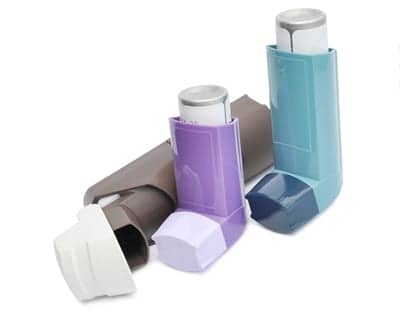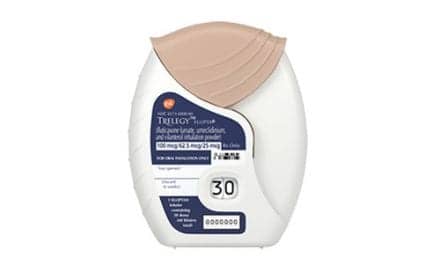A number of environmentally friendly alternatives are being developed to replace CFC-based devices.
by John D. Zoidis
The inhaled route of administration is the preferred route for delivering both bronchodilator and anti-inflammatory drugs to patients with asthma and other respiratory diseases. Inhalation devices that deliver b2-agonists, corticosteroids, and anticholinergics have become a mainstay in the management of asthma and chronic obstructive pulmonary disease (COPD). Inhalation devices are also being evaluated for the delivery of nonrespiratory medications.
The pressurized metered-dose inhaler (MDI) is still the most widely prescribed drug delivery device for inhaled medications. Currently, the propellants used in MDI formulations are one or more of the chlorofluorocarbons (CFCs) 11, 12, and 114. Overall, the contribution to the CFC atmospheric load from medical inhalers represents less than 1 percent. Nonetheless, because of increasing concerns over adverse environmental effects of CFCs, guidelines have been introduced in most countries to restrict and phase out the use of these chlorine-based propellants.
In accordance with the 1989 Montreal Protocol, an agreement signed by 140 nations, a complete phaseout of CFCs for medical inhalers is targeted for 2005.
Adverse Consequences Of CFCs
CFCs were first developed by the General Motors Corporation in 1931 for use as refrigerants. CFCs are not dissolved by rain, and gradually rise to the ozone layer in the stratosphere, about 10 to 20 miles (15 to 30 km) above the surface of the earth. This layer has been called good ozone because it serves a useful purpose and does not come into contact with living creatures. CFCs may linger in the ozone payer for centuries while the sun’s high-energy radiation breaks them down into chlorine atoms. Chlorine atoms are extremely toxic to the ozone layer–1 chlorine atom can destroy more than 100,000 ozone molecules. This destructive ability is magnified by the extreme longevity of CFC molecules.
Scientists now know that an ozone hole exists over Antarctica. Ozone levels in the area of the hole can drop by 60 percent, depending on the season, weather, and other environmental factors. According to estimates provided by the Environmental Protection Agency (EPA), ozone levels have fallen by up to 10 percent over North America, Europe, and Australia.
Damage to the ozone layer can have dire consequences to human and animal life. Ozone functions as a shield to protect us against the sun’s radiation–it absorbs most of the harmful ultraviolet radiation before it reaches the earth’s surface. Many experts believe that as ozone depletion accelerates, skin-cancer rates will rise proportionately. According to a United Nations study, a 1 percent decrease in the atmospheric ozone concentration translates into a 2 percent rise in the rate of nonmelanoma skin cancer. In addition, increased terrestrial ultraviolet radiation may result in an increased incidence of cataracts and reduced growth of terrestrial and marine life.
Global warming and increased ultraviolet radiation may lead to an increase in inhaled ozone. This “bad ozone” formation may result in a greater rate of airway problems, particularly in airway-sensitive patients such as those with asthma and COPD. Ozone is a potent oxidant that damages eyes and airway mucosa by activating inflammatory-cell activity through a cytokine-mediated mechanism.
FDA Response
The US Food and Drug Administration (FDA) has indicated that it intends to comply with the Montreal Protocol. The manufacture and use of CFCs are to be reduced and eventually eliminated. Hence, these propellants, commonly used in MDIs, will no longer be available.
Since January 1996, all domestically manufactured and imported CFC-containing MDIs intended for commercial purposes have been banned. The only exceptions to the ban are products that are considered medically essential, which include MDIs for asthma and COPD. Consequently, the CFCs in medical inhaler sprays are believed to be the only significant remaining source of stratospheric ozone depletion.
The HFA-MDI Alternative
Hydrofluorocarbons, which include hydrofluoroalkanes (HFAs), are chlorine-free alternatives to CFC-based propellants. Two HFAs, HFA 134a and HFA 227, are the replacement propellants for current and future MDI formulations. While the long-term environmental effects of HFAs have not been fully elucidated, these propellants have been demonstrated to be safe for human use, and reformulation of CFC-based MDIs is occurring for many existing products.
CFC- And HFA-Based MDIs
The MDI contains a suspension or a solution of micronized polar drug particles in either one or a mixture of two or three nonpolar propellants, chosen to achieve the desired vapor pressure and spray characteristics. In suspension formulations, particle agglomeration is reduced by the addition of a surfactant such as sorbitan trioleate, lecithin, or oleic acid; the surfactant may contribute to the characteristic taste of the aerosol.
A key hardware component of the MDI is the metering valve, which delivers a known quantity of propellant containing the micronized drug, surfactant, and any other excipients with each actuation. Following release by the actuator, volatilization of the CFC or HFA propellant breaks up the liquid droplets, resulting in a high-velocity plume that is expelled 20 cm to 30 cm into free air. As a result, a large portion of the aerosolized drug–up to 90 percent–may be deposited in the oropharynx. This has been confirmed in deposition studies in which the distribution patterns of drug particles radiolabeled with Tc-99m can be seen in the respiratory tract using gamma-camera scintigraphy.1,2
Your MDI Will Be Changing
Some of the issues of concern with CFC-based MDIs, such as dose inconsistency as the canister reaches near-empty, spray temperature, and spray velocity are eliminated or reduced with the HFA-replacement propellant formulations.3
One of the most important clinical limitations of MDIs is the fact that they must “interact” correctly with the patient in order to deliver a reliable, uniform, and consistent dose. Actuation must be coordinated with inspiration, and as such, MDIs are not well suited for use without spacers by infants, young children, the elderly, and severely ill patients. Furthermore, because it is recommended that MDIs be primed prior to use, it is often difficult to keep track of how many deliverable doses remain.In 1996, the albuterol sulfate HFA inhaler became the first non-CFC MDI to receive FDA approval. There are subtle performance differences between CFC-containing and non-CFC-containing MDIs. For example, the force of the aerosol generated by the HFA inhaler is softer than that generated by its CFC predecessor.
Because of different excipients, surfactants, and other inactive ingredients used, the HFA-based MDI may have a different taste than the CFC-based MDI. Similar changes may be perceptible for other reformulated MDIs (RMDIs), such as the HFA version of triamcinolone acetonide, which has recently been submitted for FDA approval. These characteristics may cause patients who are used to the CFC-based inhaler to think that there is something wrong with the device. They should be reassured that only the propellant has changed.
Other albuterol RMDIs, such as the albuterol sulfate HFA inhaler, are expected to use pure propellant and albuterol, with no excipients, surfactants, or other inactive ingredients. According to the International Pharmaceutical Aerosol Consortium (IPAC), between 11 and 35 RMDIs are expected to be on the market by the millennium. RMDIs undergo the same rigorous preclinical and clinical testing that all medical devices must undergo in order to receive FDA approval. According to John Jenkins, MD, Director of the Division of Pulmonary Drug Products of the FDA, “RMDIs must employ the same method of delivery and have the same level of convenience of use as their MDI predecessors.”
Adds Jenkins, “Transition will be a complex and difficult process.” The FDA aims to protect the health and safety of patients before, during, and after the transition. According to the FDA, CFC-medications will not be phased out until: 1) acceptable treatment alternatives exist for a particular MDI or other drug product so that each patient can find a product that meets his or her medical needs; 2) the alternatives are marketed for at least 1 year and are accepted by patients; and 3) the supple of alternative products is sufficient to ensure that there will be no shortages of drug.
A Closer Look At DPIs
Another alternative is the dry-powder inhaler (DPI). The DPI avoids the use of CFCs and other propellants. The key differences between the DPI and the propellant-based MDI are listed in Table 1.
According to Myrna Dolovich, PEng, a pulmonologist and director of the Department of Nuclear Medicine at McMaster University in Ontario, Canada, “Most DPIs are available with a reservoir system that contains micronized drug plus carrier. Several unique dosing systems have been designed to provide a unit dose of drug from the reservoir just prior to use. Some DPIs use gelatin capsules that contain either micronized drug mixed with a lactose or glucose carrier, or micronized drug pelletized or spheronized into visible agglomerates. A carrier or spheronization is necessary because of the cohesiveness of pure micronized drug, making filling and emptying of gelatin capsules and bulk-reservoir DPIs inefficient. Once inhaled, the drug particles separate from the carrier or are deagglomerated by the inspired airflow.”
One of the major potential problems associated with DPIs, Dolovich says, is that they rely on the patient’s inspiratory effort to enable the drug to reach the lung. “If inhalation is not performed at the optimal inspiratory flow rate for a particular device, delivery to the lung will be reduced, as the dose of drug emitted or dispensed is decreased and the particle size of the powder aerosol increased.”
Many young children as well as older children and adults with severe bronchospasm cannot generate sufficient inspiratory flow to get the most benefit from a DPI. This was one of the driving forces that led to the development of the albuterol sulfate inhaler. It has a new design, still in development, that employs electromechanical energy to provide a powered “assist” to inspiratory flow.
Conclusion
The proposed ban on CFC-based medical inhalers need not cause distress for patients or RCPs. A variety of safe, environmentally friendly alternatives are being developed for use by patients with asthma, COPD, and other pulmonary diseases that require inhalation therapy. The two most promising technologies, and the ones poised to become mainstays in inhalation pharmacotherapy, are HFA-based MDIs and non-propellant DPIs.
John D. Zoidis is a contributing writer for RT.
References
1. Newman SP, Clarke AR, Talee N, Clarke SW. Pressurized aerosol deposition in the human lung with and without an “open” spacer device. Thorax. 1989;44:706-710.
2. Dolovich M, Ruffin RE, Roberts R, Newhouse MT. Optimal delivery of aerosols from metered dose inhalers. Chest. 1981;80(suppl):911-915.
3. June D. A new generation of inhaler technology. Br J Clin Pract. 1995;79(suppl):18-21.
4. Dolovich M. Changing delivery methods for obstructive lung diseases. Curr Opin Pulm Med. 1997;3:177-189.
5. Kim CS, Garcia L. Delivery characteristics of albuterol powder aerosol by rotahaler. J Aerosol Med. 1993;8:199-211.










